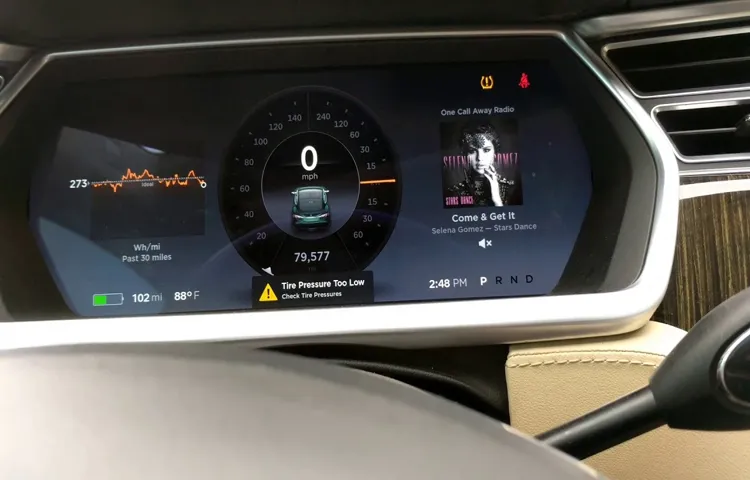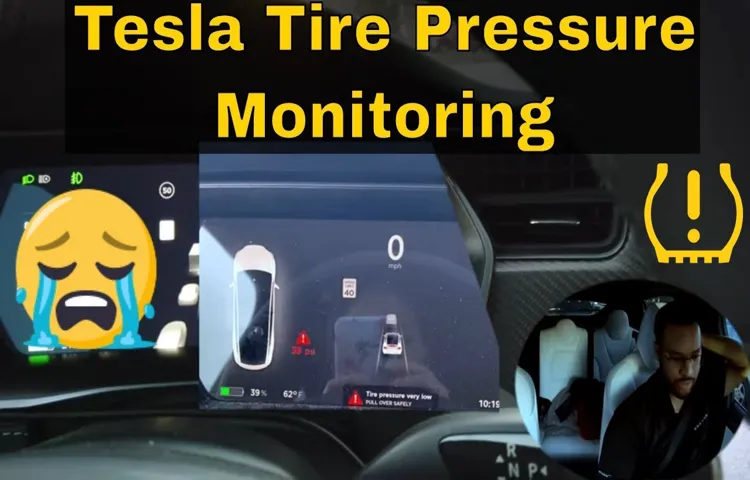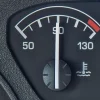Driving a Tesla is a unique experience in many ways. With its electric power, minimalist dashboard, and cutting-edge technology, it’s easy to overlook the more routine aspects of owning a car, such as checking your tire pressure. However, maintaining the proper pressure in your tires is essential for safety, performance, and fuel efficiency, and it’s just as important for a Tesla as for any other vehicle.
In this blog post, we’ll explore how to check the tire pressure on your Tesla, including which tools you need, where to find the recommended pressure levels, and some tips for optimizing your tire pressure for different driving conditions. So, let’s dive in and make sure your Tesla is ready for the road ahead!
Table of Contents
Why Checking Tire Pressure is Important
As a Tesla owner, it’s crucial to keep your vehicle in top-notch condition, and checking tire pressure is one important aspect of that. Tire pressure affects your car’s performance, safety, and fuel efficiency, which is why it’s important to check it regularly. The easiest way to check tire pressure on a Tesla is by using the built-in TPMS (Tire Pressure Monitoring System).
You can also use a tire pressure gauge to get a more accurate reading. Low tire pressure leads to increased rolling resistance, which means your car will consume more energy to move, leading to lower efficiency. Not only that, but low tire pressure also increases the likelihood of accidents due to reduced grip and handling.
Higher than recommended tire pressure, on the other hand, can lead to uneven tread wear and reduced tire life. By regularly checking your Tesla’s tire pressure, you’ll not only save money on fuel but also improve your car’s safety and performance on the road.
Safety
Tire pressure is something most car owners don’t think about until there’s a problem. However, checking your tire pressure regularly is crucial for safe and efficient driving. When your tires are underinflated, they can overheat and wear out more quickly, which can lead to a blowout.
Overinflated tires can also be dangerous, as they reduce the amount of tire surface area in contact with the road, decreasing traction and making it harder to control your vehicle. By keeping your tire pressure at the manufacturer’s recommended levels, you can extend the life of your tires, improve fuel efficiency, and most importantly, keep yourself and others safe on the road. So, don’t wait until there’s a problem.
Take a minute to check your tire pressure regularly, and ensure a smooth, safe ride every time you hit the road.

Fuel Efficiency
Checking tire pressure is one of the simplest and easiest ways to improve the fuel efficiency of your vehicle. When your tires are underinflated, they create more resistance against the road, leading to more fuel consumption. By keeping your tires properly inflated, you not only reduce the amount of gas needed to get from point A to point B, but you also extend the life of your tires.
It’s important to check your tire pressure regularly, as it can fluctuate with changes in temperature and as you put more miles on your car. Think of it like blowing up a balloon – if you don’t blow it up enough, it won’t travel as far when released. The same is true for your tires – if they’re not properly inflated, you’re wasting gas and putting unnecessary wear and tear on your tires.
So, the next time you fill up your tank, take a few extra minutes to check your tire pressure for a more efficient and cost-effective ride.
Tire Life Expectancy
Tire pressure might seem like a small detail, but it can actually play a significant role in determining your tire’s life span. Having the right tire pressure can prevent issues like uneven wear and tear and can help prolong your tire’s life expectancy. On the other hand, driving on under-inflated or over-inflated tires can lead to issues that might decrease your tire’s lifespan.
For example, under-inflated tires have the potential to overheat, which can lead to blowouts while driving. So, it’s essential to check your tire pressure regularly and ensure it’s within the appropriate range for your vehicle. By doing so, you’ll be extending your tire’s life, increasing your car’s fuel efficiency, and keeping yourself safe on the road.
Remember, a little maintenance can go a long way, and checking your tire pressure is an easy habit to form that can end up saving you money and hassle in the long run.
How to Check Tire Pressure on a Tesla
If you own a Tesla, it’s crucial to keep an eye on your tire pressure to maintain optimal performance and safety. Luckily, checking your tire pressure on a Tesla is pretty straightforward. First, locate the tire pressure label on the inside of the driver’s side door jamb.
This label displays the recommended PSI (pounds per square inch) for both front and rear tires. Next, use a tire pressure gauge to measure the pressure in each tire. Screw the gauge onto the valve stem and press down hard enough to get a good reading.
If the pressure is too low, inflate the tire until it reaches the recommended PSI. If it’s too high, release some air by pressing the gauge onto the valve stem or using a tire inflator with pressure release functionality. Repeat this process for all four tires.
Proper tire inflation not only improves handling and fuel efficiency but also extends the lifespan of your tires, making it an important maintenance task for your Tesla.
Step 1: Locate the Tire Pressure Monitoring System
If you’re unsure of how to check tire pressure on your Tesla, the first step is to locate the Tire Pressure Monitoring System, or TPMS. Tesla vehicles have a built-in TPMS that constantly monitors the pressure of each tire and alerts you if the pressure drops below a certain level. To access this system, go to the touchscreen on your dashboard and click on the ‘Tire Pressure’ icon.
From there, the system will display the current pressure of each tire, and you can check whether the pressure is adequate or not. If the pressure is low, it’s essential to refill the tire with air to avoid damage and ensure optimal performance. With the TPMS system in place, checking your Tesla’s tire pressure is as easy as the click of a button.
Step 2: Check the Recommended Pressure
When it comes to checking the tire pressure on your Tesla, it’s crucial to know the recommended pressure range. This information can usually be found in the owner’s manual or on the inside of the driver’s side door jamb. Once you have located the recommended pressure range, it’s time to check your tire pressure.
Make sure your tires are cool and use a tire pressure gauge to measure the pressure. It’s essential to remember that over or under-inflated tires can affect your car’s handling and fuel economy, so it’s always best to ensure your tires are within the recommended range. Keeping your Tesla’s tires properly inflated not only benefits your wallet by improving fuel efficiency, but it enhances your driving experience, making for a smoother ride with better handling.
So, don’t forget to check your tire pressure regularly to ensure your Tesla is in top shape.
Step 3: Use a Tire Pressure Gauge to Check the Pressure
When it comes to checking the tire pressure on your Tesla, there are a few easy steps you can follow. The first thing you’ll need is a tire pressure gauge, which can be purchased at most auto supply stores. Once you have your gauge, locate the valve stem on each tire and remove the cap.
Press the gauge onto the valve stem until you hear a hissing sound, then quickly remove it. You should see a reading on the gauge, which will tell you the current pressure of that tire. Repeat this process for all four tires, making note of any readings that are outside of your vehicle’s recommended pressure range.
It’s important to check your tire pressure regularly, as low pressure can lead to increased wear and tear on your tires, decreased fuel efficiency, and even a higher risk of accidents. So take a few minutes every month to ensure that your Tesla is safe and efficient on the roads.
Step 4: Adjust the Pressure if Necessary
When it comes to checking tire pressure on your Tesla, it’s important to know what to look for. With the right tools, it’s easy to check and adjust your tire pressure yourself. The first step is to ensure that your tires are cool to the touch, as checking the pressure on hot tires can give you inaccurate readings.
Once you’ve confirmed this, remove the valve cap and attach the pressure gauge securely to the valve stem. The gauge will give you a reading, indicating whether the pressure is too low, too high, or just right. If the gauge shows that the pressure is too low, it’s important to add air to the tires until you reach the recommended pressure level.
On the other hand, if the pressure is too high, release some air until you reach the recommended pressure level. Always remember to replace the valve cap securely once you’re done adjusting the pressure. By checking your tire pressure regularly, you’ll not only increase your safety while driving, but also save money on gas and prevent unnecessary wear and tear on your tires.
Tips for Maintaining Proper Tire Pressure
Maintaining proper tire pressure is critical for every vehicle, including Tesla cars, as it improves safety, extends the life of the tire, and helps optimize fuel efficiency, among other benefits. To check your Tesla’s tire pressure, start by finding the recommended PSI for your particular model in the owner’s manual, on the sticker inside the driver-side door, or in the driver’s display. Once you have this information, you can use a digital tire pressure gauge or visit a service center to check and adjust the pressure in each tire.
It is advisable to check the pressure at least once a month, including the spare tire, and before embarking on long trips. Remember that under-inflated or over-inflated tires can both lead to safety hazards and decreased fuel economy. Therefore, it is crucial to maintain accurate tire pressure in your Tesla to enjoy a smoother and safer ride while also preserving the longevity and performance of your car’s tires.
Check Tire Pressure Regularly
Maintaining proper tire pressure is crucial for the safety of your vehicle, and it’s a responsibility that often gets overlooked. Checking your tire pressure regularly is an essential step in ensuring that your tires are functioning as they should be. One easy way to do this is to invest in a quality tire pressure gauge and check your tires at least once a month.
Proper air pressure not only enhances your car’s handling and fuel efficiency but also helps ensure that your tires have a longer lifespan. Additionally, having the right tire pressure can prevent premature tire wear and keep you safe on the road. So, it’s important to keep an eye on your tires and maintain the recommended tire pressure to keep your car running smoothly.
Remember, a small investment in your tires’ upkeep can prevent larger repair costs down the road. So, don’t forget to give your tires the attention they deserve.
Keep Tires Properly Inflated
Proper tire inflation is essential for maintaining your vehicle’s safety, performance, and fuel efficiency. To keep your tires in their optimum shape, you should check their pressure regularly. Ideally, you should check it once a month or every time before taking a long trip.
You can find the recommended tire pressure levels in your car owner’s manual or on a label inside the driver’s door jamb. Use a reliable tire pressure gauge to check the pressure when the tires are cold. Do not rely solely on the car’s tire pressure monitoring system (TPMS) as they are not always accurate.
Overinflated tires can wear out the center of the tread quickly, while underinflated tires can lead to excessive friction, heat buildup, and premature wear. Maintaining the proper tire pressure not only ensures safety on the road but also helps you save money on gas and extends the lifespan of your tires. So, investing a few minutes of your time every month to check your tire pressure can go a long way in maintaining your vehicle’s health in the long run.
Replace Worn Tires as Needed
Maintaining proper tire pressure is crucial for ensuring your safety while driving. Not only does it improve your vehicle’s performance, but it also saves you money on fuel and prevents unnecessary wear and tear on your tires. To keep your tires in top condition, it’s important to check their pressure regularly and inflate them to the recommended level.
You can typically find this information in your vehicle’s owner manual or on the tires themselves. Another important tip for maintaining your tires is replacing them as needed. Worn tires can lead to poor handling, reduced traction, and even blowouts, so it’s essential to keep an eye out for any signs of wear and replace them promptly.
By following these simple tips, you can ensure the longevity of your tires and drive safely on the road.
Conclusion
In conclusion, checking your Tesla’s tire pressure doesn’t have to be a stressful task. Just remember to grab your tire pressure gauge, kneel down, and give those rubber babies a good squeeze. And if you’re feeling extra sassy, go ahead and sing them a little tune while you’re at it.
Trust us, they’ll appreciate the TLC and your wallet will thank you for the improved gas mileage. Now, go forth and drive with the confidence of a perfectly aired-up tire!”
FAQs
What is the recommended tire pressure for a Tesla car?
The recommended tire pressure for a Tesla car is usually between 42 and 45 PSI (pound per square inch), depending on the model.
How often should I check my Tesla’s tire pressure?
Tesla recommends checking tire pressure at least once a month. Also, it’s a good practice to check the tire pressure before heading out for a long journey.
What happens if I drive with low tire pressure on my Tesla?
Driving with low tire pressure can cause uneven wear on your Tesla’s tires and can also affect handling and fuel economy. Low tire pressure can also increase the risk of a blowout or tire failure.
Can I use a regular tire pressure gauge to check my Tesla’s tire pressure?
Yes, you can use a regular tire pressure gauge to check your Tesla’s tire pressure. However, Tesla owners can also use the built-in tire pressure monitoring system (TPMS) that comes with most models.
What should I do if my Tesla’s tire pressure is too low?
If your Tesla’s tire pressure is too low, you should add air to the tire(s) until it reaches the recommended PSI level. You can do this at a gas station, tire shop, or with your own portable air compressor.
Can cold weather affect my Tesla’s tire pressure?
Yes, cold weather can cause a decrease in tire pressure, and it’s essential to check it more frequently during winters to ensure your Tesla handles the road effectively.
How can I maintain the correct tire pressure on my Tesla for a longer time?
You can maintain the correct tire pressure on your Tesla by keeping your tires in good condition, checking them regularly, avoiding overloading, and driving carefully. It’s also recommended to get regular tire rotation and alignment checks from Tesla-certified technicians.



